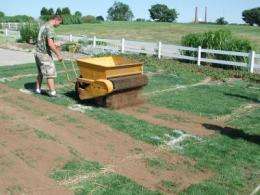Optimal topdressing applications for athletic fields determined

Scientists evaluated the effects of cumulative sand topdressing rates on the fall wear tolerance and surface shear strength of simulated athletic fields. Experimental results suggested that a 0.5-inch topdressing depth applied over a 5-week period in summer will provide improved shoot density and surface shear strength in the subsequent fall. Results also indicated that topdressing rates as thick as 4.0 inches accumulated over a 2-year period provide increased shoot density but diminished surface shear strength.
The practice of "topdressing" athletic fields with sand has been used by turfgrass professionals for years. Topdressing is essential to maintaining safe and healthy turf, and using porous sand allows the turfgrass system to retain the necessary pore space for adequate drainage, even in heavy foot traffic.
While sand-based athletic fields may be preferred by schools and municipalities, conversion to a sand-based system is expensive. Complete renovation is often cost-prohibitive and renders the field temporarily unusable. Because of these drawbacks, complete field renovation is not an option for locations with high use requirements and limited budgets. An alternative method to complete field restoration requires installing drain tiles into athletic fields, followed by applications of sand topdressing. The method is more cost-effective than complete restoration, but if cumulative topdressing rates exceed root system development, surface stability may be compromised.
In a study published in HortTechnology, Alexander R. Kowalewski and colleagues evaluated the effects of cumulative topdressing (over a compacted sandy loam soil) on the fall wear tolerance and surface shear strength of a kentucky bluegrass–perennial ryegrass stand. "The initial hypothesis of our research was that topdressing would increase turfgrass wear tolerance characteristics and surface shear strength; however, high amounts of cumulative topdressing applications would reduce these characteristics", said Kowalewski.
A well-graded, high-sand-content root zone (90.0% sand, 7.0% silt, and 3.0% clay) was topdressed at a 0.25-inch depth [2.0 lb/ft2 (dry weight)] per application, providing cumulative topdressing depths of 0.0, 0.5, 1.0, 1.5, or 2.0 inches applied from mid-July to mid-August. A traffic simulator was used for two traffic applications per week from mid-October to early November. In the following year, topdressing applications and traffic were repeated on the same experimental plots. A total topdressing depth of 1.0 inch applied over a 2-year period provided the optimum results—a combination of turfgrass cover, shoot density, and divot resistance.
Results of the experiments suggested that the 0.5-inch topdressing depth applied over a 5-week period in the summer will provide improved shoot density and surface shear strength in the subsequent fall. The research also indicated that topdressing rates as thick as 4.0 inches accumulated over a 2-year period will provide increased shoot density, but will diminish surface shear strength. The outcomes support previous findings suggesting that overall turfgrass strength will increase as a turfgrass system matures.
More information: horttech.ashspublications.org/ … nt/abstract/20/5/867
Provided by American Society for Horticultural Science

















